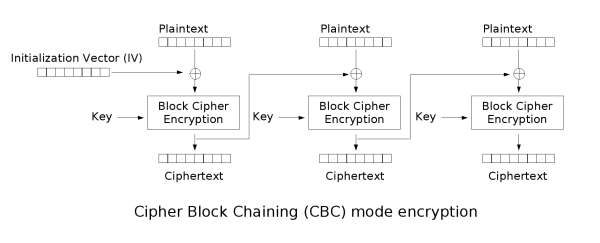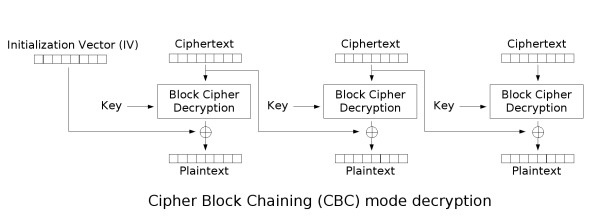前言
在AES加密算法中分有AES-128、AES-192、AES-256,而每种对加密数据的分块长度又各有要求,分别为16byte【128位、24byte【192位和32byte【256位。
在AES加密的CBC模式中,若加密数据的长度模除分块长度而有余,则会在末尾填充一组数据。
即**(pad_length-len(data)%pad_length)*hex(pad_length-len(data)%pad_length)**。
若模除后为零,则直接填充一组如上公式所示的数据。
举例
1
2
3
4
5
6
7
8
9
10
11
12
| 数据:
south
补齐后的数据:
south/x13/x13/x13/x13/x13/x13/x13/x13/x13/x13/x13
数据:
southseast
补齐后的数据:
southseast/x06/x06/x06/x06/x06/x06
数据:
southseastisacat
补齐后的数据:
southseastisacat/x10/x10/x10/x10/x10/x10/x10/x10/x10/x10/x10/x10/x10/x10/x10/x10
|
加密
 CBC_Encryption.png
CBC_Encryption.png
首先是对明文分组,根据选择的模式所要求的分组长度来分组,填充数据块。
接着初始化一个IV【初始向量和Key【秘钥。
再将第一组明文和IV异或,后同Key进行块加密。
然后将得到的密文作为下一组明文进行快加密前的IV用来异或。
如此反复,最后拼接所有密文和IV。
解密
 CBC_Decryption.png
CBC_Decryption.png
首先是从密文中截取出IV【一般是拼接在头尾。
然后对密文分组,将第一组密文先同秘钥进行解密。
接着和IV异或得到明文,第二组的密文解密后同上一组的密文异或得到明文。
如此反复到最后一组,得到明文后判断最后填充的数据是否符合**(pad_length-len(data)%pad_length)*hex(pad_length-len(data)%pad_length),若不对,即Padding**错误,抛出异常。
关于Padding Oracle
在CBC模式中,IV是不要求保密的,故对于攻击者而言,可以获取到的数据有IV和密文。
在确定了加密模式后,提取IV,并分组密文,然后构造另一组IV拼接密文发回服务器来对其进行爆破。
举例
此处选择了AES-128作为例子,明文长度为17位,故补齐至32位后分2组进行加密。
后伪造一组IV来和第一组密文一起发回服务器,让其进行判定。
1
2
3
4
5
6
| 明文:
southseastisacat!
IV:
\x31\x32\x33\x34\x35\x36\x37\x38\x38\x37\x36\x35\x34\x33\x32\x31
密文:
\xbf\x61\xb3\x1b\xd3\x6a\x47\x11\xb9\xcc\xd7\x11\x7b\x8a\x42\xd9\x3a\x1e\x37\xe9\xd2\xde\xfa\xca\xa2\x50\xfd\xc0\x6e\xf2\x11\xc1
|
对最后一位字符进行爆破,构造0x00到0xff,使得第一组密文的最后一个字节解密的结果同IV异或结果为0x01,导致Padding通过,服务器返回正确结果。
这时IV的最后一个字节和原IV的最后一个字节还有0x01异或,即0x44^0x31^0x01,得到结果为t,是第一组明文的最后一个字符。
1
2
3
4
| 第一组密文:
\xbf\x61\xb3\x1b\xd3\x6a\x47\x11\xb9\xcc\xd7\x11\x7b\x8a\x42\xd9
IV:
\x00\x00\x00\x00\x00\x00\x00\x00\x00\x00\x00\x00\x00\x00\x00\x44
|
这个就是逆推的公式。
1
2
3
4
5
6
| ∵
decryp(cipher) ^ iv = plain
decryp(cipher) ^ fake_iv = new_plain
new_plain[-1:] = 0x01
∴
fake_iv[:-1] ^ iv[:-1] ^ plain[:-1] = 0x01
|
例题
hulk
这是BCTF 2017的一道题。
1
2
3
4
5
6
7
8
9
10
11
12
13
14
15
16
17
18
19
20
21
22
23
24
25
26
27
28
29
30
31
32
33
34
35
36
37
38
39
40
41
42
43
44
45
46
47
48
49
50
|
class Unbuffered(object):
def __init__(self, stream):
self.stream = stream
def write(self, data):
self.stream.write(data)
self.stream.flush()
def __getattr__(self, attr):
return getattr(self.stream, attr)
import sys
sys.stdout = Unbuffered(sys.stdout)
import random
import binascii
import re
from mycryptolib import *
def hex2charlist(hexstr):
charlist = []
length = len(hexstr)
if length % 2 != 0:
hexstr = '0' + hexstr
length += 1
for i in range(0, length, 2):
charlist.append(chr(int(hexstr[i]+hexstr[i+1], 16)))
return charlist
if __name__ == '__main__':
pattern = '\A[0-9a-fA-F]+\Z'
request1 = raw_input('Give me the first hex vaule to encrypt: 0x').strip()
if len(request1) > 96 or not re.match(pattern, request1):
print 'invalid input, bye!'
exit(0)
plaintext1 = "".join(item for item in hex2charlist(request1)) + flag
ciphertext1 = encrypt(plaintext1, refresh_key = True)
plaintext1_str = request1+'|flag'
ciphertext1_str = ciphertext1.encode('hex')
print 'plaintext: 0x%s\nciphertext: 0x%s' % (plaintext1_str, ciphertext1_str)
request2 = raw_input('Give me the second hex vaule to encrypt: 0x').strip()
if len(request2) > 96 or not re.match(pattern, request2):
print 'invalid input, bye!'
exit(0)
plaintext2 = "".join(item for item in hex2charlist(request2))
ciphertext2 = encrypt(plaintext2, iv_p = str(ciphertext1[-16:]), refresh_key = False)
plaintext2_str = request2
ciphertext2_str = ciphertext2.encode('hex')
print 'plaintext: 0x%s\nciphertext: 0x%s' % (plaintext2_str, ciphertext2_str)
|
源码中,在对第二次获取到的明文加密时,使用的IV是第一次密文的后十六个字节,故推出这是一个AES-128加密,分组长度为16比特。
此中,密文采用了ASCII十六进制的表示方法,即两个字符表示一个字节的十六进制数,这是因为密码学算法中得到的密文经常会出现不可打印字符。因此16个字节加密后得到的会是32字节的密文长度。
测试了一下,在输入数据的字节数从9字节增长到10字节的时候,密文长度增加了16x2,因此根据前文,当明文模除分组长度【16为0时填充一个16x/0x10的Padding,推测出flag的长度为38字节,填充后分组加密,密文长度为48字节。
举例
爆破得出flag的第1字节。
构造第一次输入的Payload长度需为47字节,拼接flag后,明文长度共计85字节,共分六组。
其中由于拼接明文和flag,因此第48字节为flag的第一字节,分组后位于密文的第三组最后一位,将第二组密文作为IV异或后加密。
而第二次输入的明文和第一次加密的第六组密文异或后加密。
所以如果第一次输入的第三组和第二次输入的第一组的IV与明文的异或结果一样,密钥也一样,那么其加密后的密文也就一样。
则此处可以爆破构造输入,已知IV,可以通过爆破明文的方式。
1
2
3
4
5
6
7
8
| # 第一次输入的第三组加密
fir_iv = fir_cipher[2]
encryp(fir_plain[3] ^ fir_iv) = fir_cipher[3]
# 第二次输入的第一组加密
sec_iv = fir_cipher[6]
encryp(sec_plain[1] ^ sec_iv) = sec_cipher[1]
# 联立等式,第三组明文前十五字节已知,需要爆破fir_plain[3]最后一个字节。
fir_plain[3] ^ fir_cipher[2] ^ fir_cipher[6] = sec_plain[1]
|
然后,使得fir_cipher[3]==sec_cipher[1]的最后一个字节就是flag的第一个字节。
最后构造payload长度为46字节,引入后面拼接的flag的两个字节到第三分组,此时已知flag的第一个字节,那么继续爆破第二个字节即可,以此类推,脚本借鉴自Nu1L。
1
2
3
4
5
6
7
8
9
10
11
12
13
14
15
16
17
18
19
20
21
22
23
24
25
26
27
28
29
30
31
32
33
34
35
36
37
38
39
40
41
42
43
44
|
import sys
from zio import *
flag = ''
target = ('127.0.0.1', 9999)
step = 32
dic = "0123456789abcdefghijklmnopqrstuvwxyzABCDEFGHIJKLMNOPQRSTUVWXYZ{}"
def xor(cipher_2, cipher_6, payload):
return ''.join(chr(ord(cipher_2[i]) ^ ord(cipher_6[i]) ^ ord(payload[i])) for i in xrange(16))
def get_flag(i, part_flag):
io = zio(target, timeout=5, print_read=COLORED(NONE, 'red'), print_write=COLORED(NONE, 'green'))
io.read_until('encrypt: 0x')
fir_plain = ('a' * (48 - i)).encode('hex')
io.writeline(fir_plain)
io.read_until('ciphertext: 0x')
fir_cipher = io.read_line()[:-1]
fir_cipher = [fir_cipher[j:j + step] for j in range(0, len(fir_cipher), step)]
payload = ('a' * (39 - len(flag + part_flag)) + flag + part_flag)[-16:]
sec_plain = xor(fir_cipher[1].decode('hex'), fir_cipher[-1].decode('hex'), payload).encode('hex')
io.read_until('encrypt: 0x')
io.writeline(sec_plain)
io.read_until('ciphertext: 0x')
sec_cipher = io.read_line()[:32]
io.close()
return 1 if fir_cipher[2] == sec_cipher else 0
for i in xrange(1, 39):
for part_flag in dic:
if get_flag(i, part_flag):
flag += part_flag
sys.stdout.write("\r%s" % flag)
sys.stdout.flush()
break
|
Refer
我对Padding
Oracle攻击的分析和思考(详细)
Web狗要懂的Padding
Oracle攻击
Padding
Oracle

